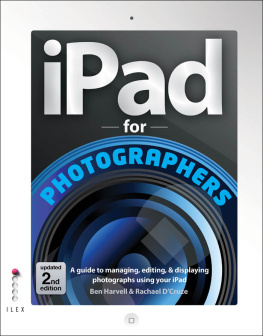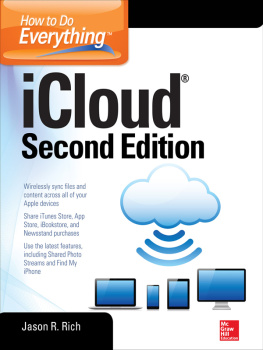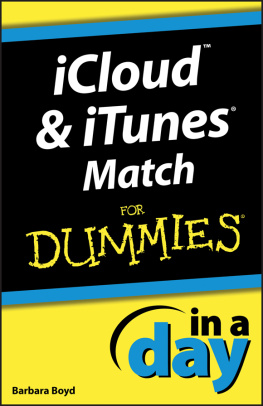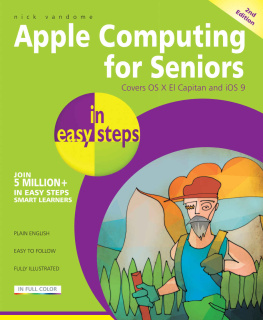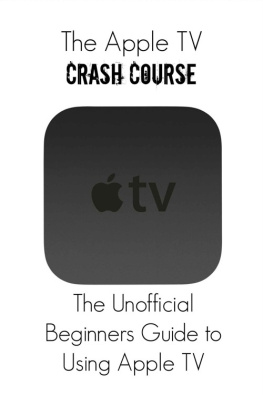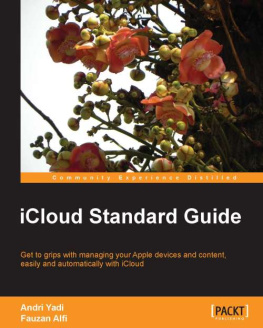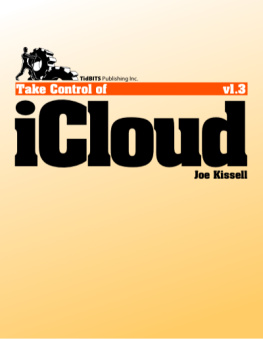iConnected
Use AirPlay, iCloud, Apps, and More
to Bring Your Apple Devices Together
Legal and Copyright Information
Published by
John Wiley & Sons, Inc.
10475 Crosspoint Boulevard
Indianapolis, IN 46256
www.wiley.com
Copyright 2013 by John Wiley & Sons, Inc.
ISBN: 978-1-118-67301-0

No part of this publication may be reproduced, stored in a retrieval system or transmitted in any form or by any means, electronic, mechanical, photocopying, recording, scanning or otherwise, except as permitted under Sections 107 or 108 of the 1976 United States Copyright Act, without either the prior written permission of the Publisher, or authorization through payment of the appropriate per-copy fee to the Copyright Clearance Center, 222 Rosewood Drive, Danvers, MA 01923, (978) 750-8400, fax (978) 646-8600. Requests to the Publisher for permission should be addressed to the Permissions Department, John Wiley & Sons, Inc., 111 River Street, Hoboken, NJ 07030, (201) 748-6011, fax (201) 748-6008, or online at http://www.wiley.com/go/permissions.
Limit of Liability/Disclaimer of Warranty: The publisher and the author make no representations or warranties with respect to the accuracy or completeness of the contents of this work and specifically disclaim all warranties, including without limitation warranties of fitness for a particular purpose. No warranty may be created or extended by sales or promotional materials. The advice and strategies contained herein may not be suitable for every situation. This work is sold with the understanding that the publisher is not engaged in rendering legal, accounting, or other professional services. If professional assistance is required, the services of a competent professional person should be sought. Neither the publisher nor the author shall be liable for damages arising herefrom. The fact that an organization or website is referred to in this work as a citation and/or a potential source of further information does not mean that the author or the publisher endorses the information the organization or website may provide or recommendations it may make. Further, readers should be aware that Internet websites listed in this work may have changed or disappeared between when this work was written and when it is read.
For general information on our other products and services or to obtain technical support, please contact our Customer Care Department within the U.S. at (877) 762-2974, outside the U.S. at (317) 572-3993 or fax (317) 572-4002.
Wiley also publishes its books in a variety of electronic formats and by print-on-demand. Some content that appears in standard print versions of this book may not be available in other formats. For more information about Wiley products, visit us at www.wiley.com.
Library of Congress Control Number: 2012955838
Trademarks: Wiley and the Wiley wordmark logo are trademarks or registered trademarks of John Wiley & Sons, Inc. and/or its affiliates. All other trademarks are the property of their respective owners. John Wiley & Sons, Inc. is not associated with any product or vendor mentioned in this book.
Credits
Acquisitions Editor: Aaron Black
Editorial Director: Robyn Siesky
Business Manager: Amy Knies
Senior Marketing Manager: Sandy Smith
Vice President and Executive Group Publisher: Richard Swadley
Vice President and Executive Publisher: Barry Pruett
Editor: Carol Person , The Zango Group
Technical Editor: Galen Gruman
Design and Layout: Galen Gruman , The Zango Group
Cover Designer: Michael E. Trent
Copy Editing, Proofreading, and Indexing: The Zango Group
Introduction
A Brief History of Apple Online
So you want to know about iCloud and AirPlay. Good, youve come to the right place. I will, however, in my capacity as author and Apple aficionado, first need to take you on a short history of Apples online and streaming services before we reach the Promised Land that both products embody.
Weve come a long way, baby
Yes, I appreciate that you probably want to know how to sync your e-mails or access iTunes purchases from your iPhone. I assure you, well get there soon. I simply think its important that you get a little perspective on iCloud (and a brief mention of the birth of AirPlay) before breaking down their features and usage. If youre really not in the mood for a history lesson, by all means skip to , but Ill do my best to keep things brief while filling you in on the ups and downs of Apples adventures online. You see, as much as both iCloud and AirPlay look like polished tools these days, things werent always this way.
The eWorld Debacle
As the word Internet became more frequently used and understood by the public in 1994, a partnership between AOL and Apple saw the launch of eWorld. With its colorful graphics and mock town square layout (see Figure I-1), it was a unique route to the web for those struggling to make sense of all this talk of superhighways and megabits, featuring an e-mail client, news reader, and communities (filled with ePeople!). eWorld, without marketing or advertising in a particularly troubling financial period for Apple, was ultimately a failure and the town closed its gates on March 31, 1996. While AOL took up the mantle with its web service and seemingly relentless free trials on CD (you know, the things you used as coasters throughout the late 1990s), Apple still harbored dreams of an online service.
Figure I-1
The town square layout of the eWorld interface in 1994
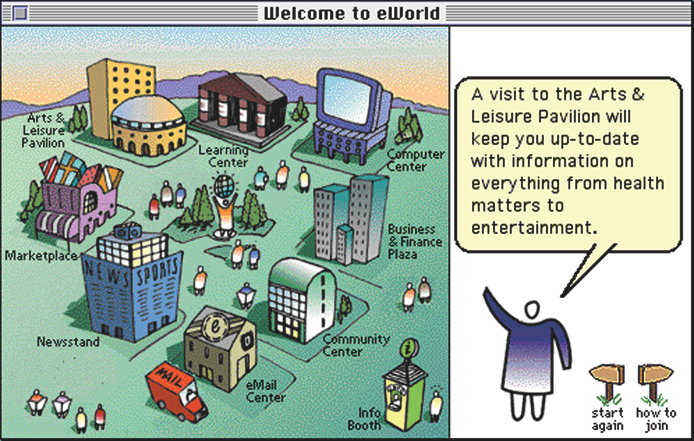
New Beginnings with iTools
By the new millennium, the company had decided that a preceding i in a product name was far more trendy than an e, and it brought iTools (see Figure I-2) to the Mac in January 2000. iTools launched as a free product with four main selling points. First there was KidSafe, a website filter designed to alleviate fears that children would be instantly corrupted after typing three Ws into a web browser. Second, there was Mac.com, the beginning of the famed @mac.com e-mail address. iDisk offered a whopping 20MB of online storage accessed from the desktop, and then there was HomePage, a rudimentary website builder. At the launch of iTools, Steve Jobs, Apples then CEO, proclaimed Mac users can now do things on the Internet that Wintel users can only dream of. Later, Apple would update iTools to use WebDAV technology, allowing it to be used outside the Mac platform and developed an iTools application for Windows XP.
Figure I-2
iTools offered new features such as the @mac.com e-mail address
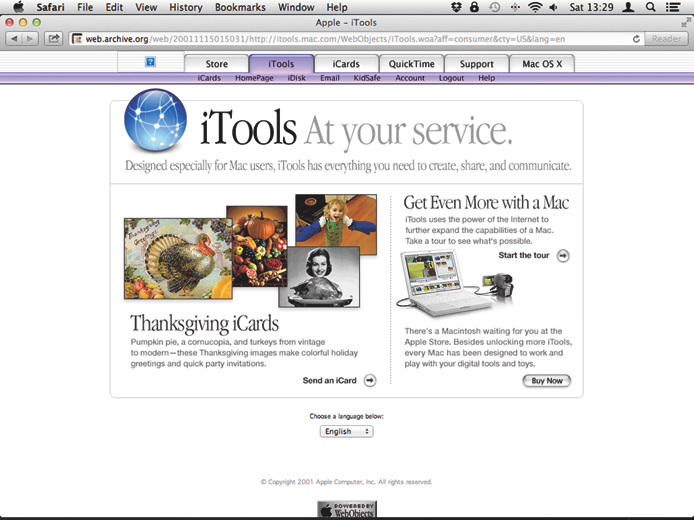
The Year of .Mac
Its fair to say that the lure of Apples iTools and its replacement, .Mac, was chiefly the cachet of an @mac.com e-mail address, more advanced features were in the pipeline, however, as the service began to take the shape of the tools we know today. As Apples fortunes began to turn in the early 2000s, with consumers looking for an alternative to Windows and the idea of being a Mac user becoming cool again, iTools was renamed .Mac and several new features were introduced, including backup and a virus scanner provided by McAfee. In late 2002, over one hundred thousand users had subscribed to .Mac at the lofty cost of $99.99 per year with a free transition period for iTools users and a discounted rate. Additional features were added during the six-year run of .Mac, including an online photo and video sharing tool, up to 30GB storage (at additional cost), and enhanced e-mail service. During this period, in June 2004, Apple also announced the new AirPort Express base station featuring a protocol called AirTunes for streaming audio across a network. This would, of course, eventually become AirPlay. But now back to the online stuff.

